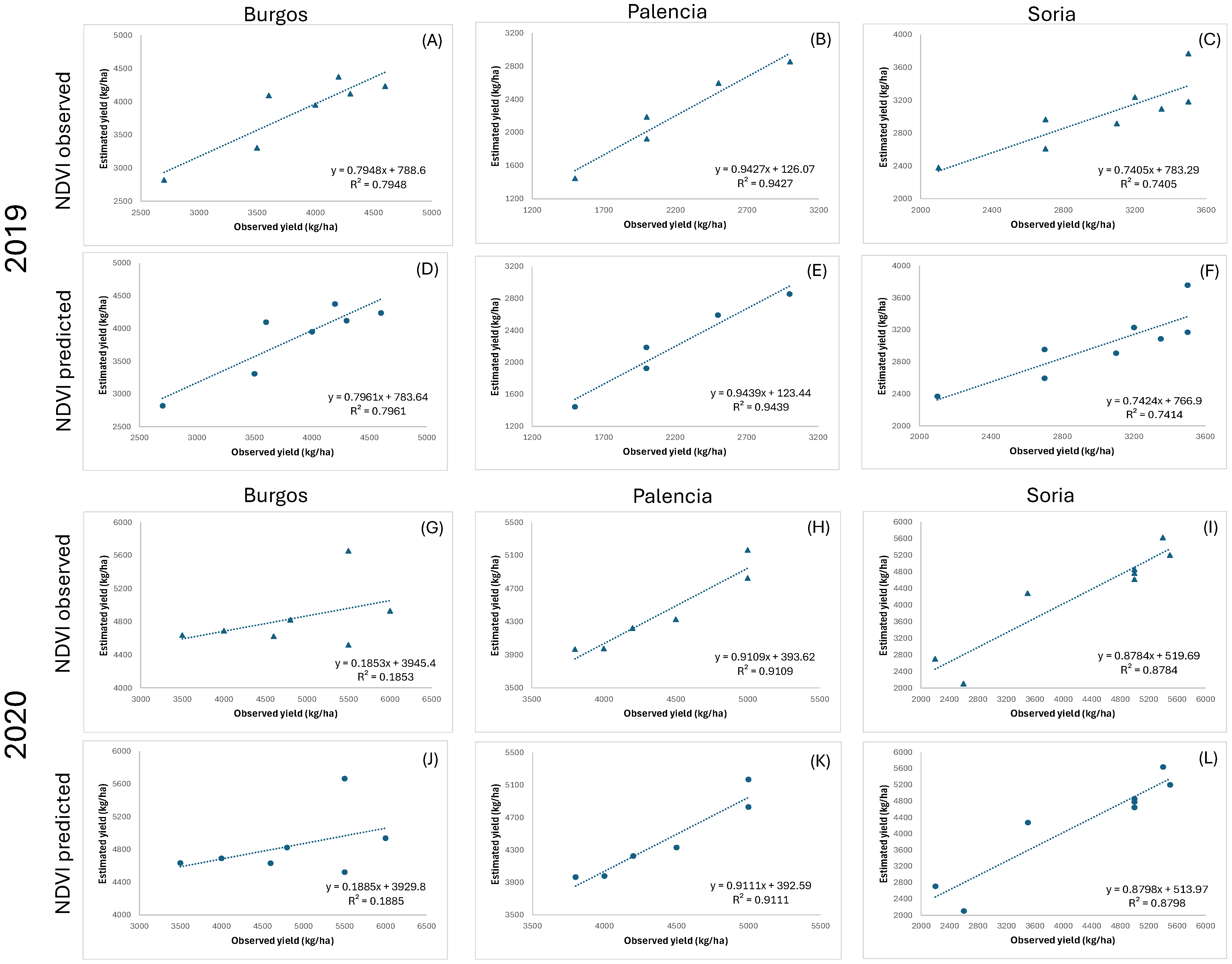Estimation and Prediction of Cereal Production Using Normalized Difference Vegetation Index Time Series (Sentinel-2) Data in Central Spain †
Abstract
:1. Introduction
2. Materials and Methods
2.1. Study Region
2.2. Data Source and Processing
2.2.1. Meteorological Data
2.2.2. Data Yield of Wheat and Barley
2.2.3. Sentinel-2 Data
2.3. Methodology
2.4. Research Methods
2.4.1. Calculation of NDVI and Compilation of Time Series
- -
- RNIR: reflectance in the near-infrared band (NIR) (band b8 in Sentinel-2);
- -
- RRED: reflectance in the red band (RED) (band b4 in Sentinel-2).
2.4.2. NDVI Time Series Modeling
- I.
- Identification.
- II.
- Estimation.
- III.
- Validation.
- IV.
- Forecasting.
- V.
- Evaluation.
2.4.3. Multiple Linear Regression Model
3. Results
4. Discussion and Conclusions
Author Contributions
Funding
Institutional Review Board Statement
Informed Consent Statement
Data Availability Statement
Acknowledgments
Conflicts of Interest
References
- Ministerio de Agricultura Pesca y Alimentación. Anuario de Estadística Agraria 2022; Ministerio de Agricultura Pesca y Alimentación: Madrid, Spain, 2022. [Google Scholar]
- Consejería de Agricultura Ganadería y Desarrollo Rural. Anuario de Estadística Agraria de Castilla y León 2021; Junta de Castilla y Leon: Valladolid, Spain, 2023. [Google Scholar]
- Mancini, A.; Solfanelli, F.; Coviello, L.; Martini, F.M.; Mandolesi, S.; Zanoli, R. Time Series from Sentinel-2 for Organic Durum Wheat Yield Prediction Using Functional Data Analysis and Deep Learning. Agronomy 2024, 14, 109. [Google Scholar] [CrossRef]
- Box, G.E.P.; Jenkins, G.M.; Reinsel, G.C. Time Series Analysis: Forecasting and Control, 3rd ed.; Wiley: Englewood Cliffs, NJ, USA, 1994. [Google Scholar]
- Köppen, W. Das Geographische System der Klimate; Gebrüder Bornträger: Berlin, Germany, 1936. [Google Scholar]
- Asadi, S.; Bannayan, M.; Monti, A. The Association of Crop Production and Precipitation; a Comparison of Two Methodologies. Arid. Land Res. Manag. 2019, 33, 155–176. [Google Scholar] [CrossRef]
- Ministerio de Agricultura Pesca y Alimentación. Encuesta Sobre Superficies y Rendimientos de Cultivos Publicación Elaborada Por La; Ministerio de Agricultura Pesca y Alimentación: Madrid, Spain, 2022. [Google Scholar]
- Tucker, C.J. Red and Photographic Infrared Linear Combinations for Monitoring Vegetation. Remote Sens. Environ. 1979, 8, 127–150. [Google Scholar] [CrossRef]
- Whittaker, E. On a New Method of Graduation. Proc. Edinb. Math. Soc. 1923, 41, 63–75. [Google Scholar] [CrossRef]
- Ljung, G.M.; Box, G.E.P. On a Measure of Lack of Fit in Time Series Models. Biometrika 1978, 65, 297–303. [Google Scholar] [CrossRef]
- Theil, H. Principles of Econometrics; John Wiley & Sons.: New York, NY, USA, 1971. [Google Scholar]
- Iranzo, C.; Montorio, R.; García-Martín, A. Estimation of Barley Yield from Sentinel-1 and Sentinel-2 Imagery and Climatic Variables. Rev. Teledetec. 2022, 2022, 61–72. [Google Scholar] [CrossRef]






| Province | Area (ha) | Production (Tn) |
|---|---|---|
| Burgos | 396,635 | 1,885,122 |
| Palencia | 304,111 | 1,268,512 |
| Soria | 225,639 | 887,833 |
| Total | 2,041,440 | 9,213,250 |
| Province | Plot | U Theil | UB | UV | UC |
|---|---|---|---|---|---|
| Burgos | BUR_P1 | 0.00882 | 0.00162 | 0.00012 | 0.99826 |
| BUR_P2 | 0.01705 | 0.00194 | 0.00020 | 0.99786 | |
| BUR_P3 | 0.01784 | 0.00294 | 0.00059 | 0.99647 | |
| Palencia | PAL_P1 | 0.03884 | 0.00199 | 0.00158 | 0.99642 |
| PAL_P2 | 0.03607 | 0.00208 | 0.00149 | 0.99644 | |
| PAL_P3 | 0.04029 | 0.00201 | 0.00136 | 0.99663 | |
| Soria | SOR_P1 | 0.00425 | 0.00150 | 0.00001 | 0.99850 |
| SOR_P2 | 0.01255 | 0.00163 | 0.00011 | 0.99826 | |
| SOR_P3 | 0.00780 | 0.00101 | 0.00003 | 0.99896 |
Disclaimer/Publisher’s Note: The statements, opinions and data contained in all publications are solely those of the individual author(s) and contributor(s) and not of MDPI and/or the editor(s). MDPI and/or the editor(s) disclaim responsibility for any injury to people or property resulting from any ideas, methods, instructions or products referred to in the content. |
© 2024 by the authors. Licensee MDPI, Basel, Switzerland. This article is an open access article distributed under the terms and conditions of the Creative Commons Attribution (CC BY) license (https://creativecommons.org/licenses/by/4.0/).
Share and Cite
Sáenz, C.; Bermejo-Saiz, A.; Cicuéndez, V.; Pugni, T.; Madruga, D.; Palacios-Orueta, A.; Litago, J. Estimation and Prediction of Cereal Production Using Normalized Difference Vegetation Index Time Series (Sentinel-2) Data in Central Spain. Eng. Proc. 2024, 68, 26. https://doi.org/10.3390/engproc2024068026
Sáenz C, Bermejo-Saiz A, Cicuéndez V, Pugni T, Madruga D, Palacios-Orueta A, Litago J. Estimation and Prediction of Cereal Production Using Normalized Difference Vegetation Index Time Series (Sentinel-2) Data in Central Spain. Engineering Proceedings. 2024; 68(1):26. https://doi.org/10.3390/engproc2024068026
Chicago/Turabian StyleSáenz, César, Alfonso Bermejo-Saiz, Víctor Cicuéndez, Tomás Pugni, Diego Madruga, Alicia Palacios-Orueta, and Javier Litago. 2024. "Estimation and Prediction of Cereal Production Using Normalized Difference Vegetation Index Time Series (Sentinel-2) Data in Central Spain" Engineering Proceedings 68, no. 1: 26. https://doi.org/10.3390/engproc2024068026
APA StyleSáenz, C., Bermejo-Saiz, A., Cicuéndez, V., Pugni, T., Madruga, D., Palacios-Orueta, A., & Litago, J. (2024). Estimation and Prediction of Cereal Production Using Normalized Difference Vegetation Index Time Series (Sentinel-2) Data in Central Spain. Engineering Proceedings, 68(1), 26. https://doi.org/10.3390/engproc2024068026







